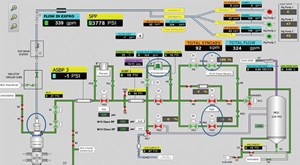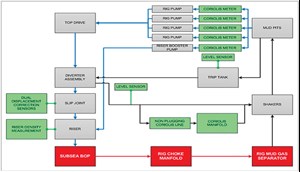Pressure prediction system advances well control event detection and prevention
Recent field-testing of a pore pressure/fracture gradient margin verification system, based on managed pressure drilling (MPD) methods, is a key advance in addressing wellbore uncertainty in challenging deepwater environments.
The successful tests of the pressure determination system (PDS) demonstrate the ability to detect an unsafe change in formation pressure margins while drilling in an automated fashion, Fig. 1. The capability to verify pore and fracture pressures, while drilling, can be used to alert the driller to unexpected changes in formation pressure trends that could lead eventually to a hazardous well control event. The alarm also could help ensure an optimal wellbore pressure to increase ROP and reduce the risk of NPT.
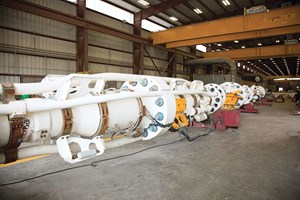
The PDS is part of a broader wellbore monitoring and event detection system that also includes rapid, advanced kick and loss detection in deepwater wells. As part of an integrated network of pressure, temperature and flowrate sensors, the system actively analyzes real-time data for deviations from expected behavior in vessel motion and rig activities to reduce the risk of false alarms.
DRILLING IN THE WINDOW
In a standard, overbalanced drilling program, the wellbore pressure gradient must be maintained above the pore pressure gradient hydrostatically (to prevent an influx) and below the fracture pressure gradient when flowing (to avoid mud loss). Further optimization of wellbore pressure is also needed to reduce the risk of hole instability, as well as maximize penetration rates. Conventional drilling operations do this by managing hydrostatic pressure and circulating friction, using a relatively slow process of changing drilling fluid rheology and mud pump rates.
On the other hand, MPD achieves changes in wellbore pressure by sealing the top of the wellbore around the drill pipe, to divert drilling returns to a choke where annular surface backpressure is applied.
Conventional and MPD responses to wellbore pressure are complicated by uncertainty about formation pore pressure and fracture pressure gradients. As one example, uncertainty is particularly acute in offshore carbonate formations, where the brittle, fractured rock can contain abnormally high-pressure zones with the potential of a kick, and low-pressure zones that result in mud losses. Drilling through depleted zones also creates pressure control challenges.
Deepwater wells have lower overburden stress, compared to shallow-water wells, resulting in a tighter formation pressure window between pore and fracture pressure. These projects also have relatively long choke and kill lines that can generate a high frictional pressure drop. In such an environment, there is a higher probability that a large influx can result in a kick-loss event, and ultimately a loss in hole section.
To mitigate these risks, drilling margins are estimated during well planning, using a variety of data, including seismic surveys, empirical correlations, and logs from nearby wells. Confidence in these predictions varies widely, depending on the available data.
Leak-off or formation integrity tests are performed to resolve uncertainty, but these have inherent limitations. For example, the tests typically are performed at the start of each hole section, to confirm that the formation exposed below the casing shoe is strong enough to hold the pressure expected in the section. While this works for the top of a hole section, it does not account for the possibility that the weakest formation interval could be deeper in the section and not yet exposed. In these circumstances, a weaker-than-expected fracture gradient is determined only when losses are sustained.
In conventional drilling, pore pressure is often not verified proactively, as operations progress. Instead, an analysis of certain drilling parameters and cuttings can suggest the possibility of entering a high-pressure zone. However, there is no conventional process for pore pressure validation while drilling. As a result, an inaccurate pore pressure estimate may not be recognized until after an influx has occurred.
This general uncertainty poses two key problems: 1) the actual formation pressure environment is often not verified until after an event occurs; and 2) large kick volumes in narrow-margin hole sections can be challenging to address and increase the risk of a losing a hole section. As a result, technology to prevent, or rapidly detect and respond to the well control event is especially critical in deepwater drilling.
CONVENTIONAL CHALLENGES
Many factors complicate conventional offshore well control event detection, including vessel motion and static flow check variables. Detection relies on changes in mud return flowrate and active pit volumes, to determine if a kick or loss has occurred. An increase in flowrate and trip tank/pit volumes indicates an influx, while a reduction represents lost returns. However, in deepwater drilling, mud return flowrates and pit levels are always changing, due to the expansion and contraction of the riser’s telescopic slip joint that allows for vessel motion.
Static flow checks, when the rig mud pumps are shut down to determine if the well is flowing, are complicated by ballooning, in which the formation returns a small amount of drilling mud to the wellbore when the mud pumps are turned off. The difference between ballooning and an influx is not known immediately, and kick volume may increase in the additional time needed to diagnose the cause and ultimately shut-in the BOP. Detection is complicated further by mud draining back into the active pits when the pumps are stopped, which can appear to be unintentional flow.
Finally, the fluid properties and flowrate injected into the well are not always known with confidence. Mud pump flowrates calculated with stroke counters do not take into account pump efficiency. Furthermore, the actual fluid density discharged by the rig pumps is not monitored directly on conventional operations.
These changes in trip tank/active pit volumes and flowrate, due to vessel motion, ballooning, temperature changes, and uncertainty on the flowrate into the well, must be deciphered from changes in the same indicators, due to a well control event. The capability to do this is limited further by the precision of the paddle flow meter. Additionally, differences in trip tank sensor readings, due to a loss in calibration, can further reduce the confidence of the rig crew to confidently detect a well control event in rapid fashion
These variables make it difficult to determine what the actual flowrate from the well is at any given time. To compensate, the driller typically accepts a degree of variation in kick/loss indicators, based on experience. This tolerance to changes in flowrate and trip tank/active pit volume can result in larger-than-necessary kicks and losses. In deepwater drilling, the severity of this issue is compounded by a reduced kick tolerance, which reduces the maximum influx volume that can be removed safely from the well by conventional means.
PDS TESTING
The pressure determination system (PDS) changes MPD from a reactive technique to a proactive system that validates pore and fracture estimates, and ultimately ensures that safe, optimal wellbore pressure is maintained during drilling operations. Testing during offshore drilling operations demonstrated the capability of the PDS to detect a simulated, unsafe change in fracture margin without incurring significant losses.
The PDS operates by oscillating a dedicated pressure control valve (PCV) in a repeatable, gradual fashion, and analyzing the resulting pressure behavior over time. The oscillation produces a deformed wave-cycle when the average wellbore pressure approaches the pore pressure or fracture gradient margin. Detection of an unexpected deformation enables the driller to proactively adjust average wellbore pressure to prevent the occurrence of a well control event, maximize ROP, and reduce the probability of NPT events.
Field testing assessed two capabilities: 1) signal transmission reliability; and 2) simulated fracture detection. The signal transmission reliability test showed that the PDS can oscillate the choke in a controlled, consistent fashion, and create highly repeatable, applied surface backpressure (ASBP), BHP, and flowrate waves over time. The simulated fracture margin test demonstrated the sensitivity of the system to detect a fracture margin at 20 psi above the target wellbore pressure, with a negligible volume loss while oscillating wellbore pressure.
Both tests were performed offshore in an openhole section of a medium-depth well, with a rotating, reciprocating drillstring. Prior to field testing, a system integrity test (SIT) was performed on PDS equipment installed on a MPD pressure control manifold (PCM). The SIT was performed with the PCM isolated from wellbore riser returns.
The PDS concept was validated at a facility where the field tests were performed initially, using a flow loop. The tests demonstrated the sensitivity of the PDS system with a 4-in. Coriolis meter in a small, closed loop system detecting less than a one gallon/min. difference in flow.
PDS OPERATION
The PDS system allows the driller to proactively manage wellbore pressure in real-time MPD operations. By detecting the onset of an unsafe, unexpected deviation from expected formation pressure gradients, the software system provides rapid, accurate information needed to prevent a change in formation pressure trends from resulting in a well control event or other loss in productive time.
The PDS oscillates the opening size of a choke between two pre-programmed positions while taking mud returns. Done in a slow, controlled fashion, the action precisely increases or decreases wellbore pressure and flow out of the riser. Over time, the acquired data establish reliable pressure fingerprints for various drilling operations.
A Coriolis meter upstream of the choke measures flow out of the riser. Wellbore pressure changes are inferred by tracking applied surface backpressure (ASBP). A bottomhole pressure sensor, such as the PWD can be used when available. The software analyzes the peaks and troughs of ASBP and flow-out wave profiles. Brief changes at the peaks or troughs that are symptomatic of a kick or loss are used to confirm variations in the formation pressure gradient. Because the peaks and troughs of the waveforms exist very briefly, kick or loss volumes are negligible, and the average wellbore pressure remains within drilling margins.
The software also uses live rig data to ensure that return rates and wellbore pressure measurements account for rig activities that can impact the same indicators, such as mud rheology, drillstring rotation, mud pump injection rate, and intended adjustments in average choke pressure. This process continuously validates the expected wellbore pressure and flow-out fingerprint. Detection of an unsafe drilling margin prompts the rig crew to proactively adjust average wellbore pressure, to prevent the development of a recordable well control event.
PDS testing conducted in a live offshore drilling environment demonstrated that the system could detect a weakening fracture gradient that had degraded to 20 psi above average wellbore pressure with only half the lost returns.
Drilling conditions included a medium depth, openhole, side-tracked wellbore, with drill-string rotation and reciprocation using oil-based mud pumps at 300 gpm.
The MPD operations used a rotating control device to seal the riser around drill pipe and divert riser flow to a topside Coriolis meter and choke manifold. Testing involved partially opening one of the chokes and oscillating the other, Fig. 2.
Two tests were conducted. A signal reliability test verified that the PDS could create repeatable flow-out and ASBP over time, enhancing the reliability of detected changes. Choke application of ASBP was consistent and behaved as intended throughout each oscillation.
The second test involved the detection of a weaker-than-expected fracture gradient. For safety in this first effort, the test was simulated by opening a ½-in. bleed-off line, upstream of the choke system and Coriolis meter. The results showed the system’s ability to detect a fracture gradient weakened to only 20 psi above average wellbore pressure, and with only ½ bbl of lost fluid.
This level of detection enables proactive adjustment of wellbore pressure using various techniques to maintain wellbore pressure within formation gradients. These methods include: 1) reducing ASBP; 2) reducing pump rate; 3) slower rotation; and 4) changing mud rheology. This prevents the development and occurrence of a significant well control event and further enhances productivity, Fig. 3.
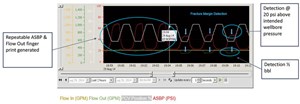
As an additional means of validating the results, a comparison of ASBP and pressure-while-drilling (PWD) data was performed, to ensure that pressure signals generated at surface are observed throughout the wellbore, as intended. Figure 4 shows that bottomhole pressure tracks ASBP with minimal distortion, and with an offset that is expected, due to the lag time for a pressure signal to travel. Furthermore, a detailed look at the flow-out and ASBP demonstrates the repeatability of flow-out behavior, due to compressibility and the deformation of this wave profile when a simulated fraction margin is detected.
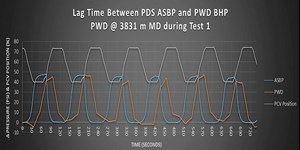
ADVANCED KICK DETECTION FOR DEEPWATER
In addition to the PDS, an advanced kick detection system for deep water is being developed to address the transient nature of flowrates and pit volumes. A prototype being explored calculates expected flow-out and pit volumes in real time, to allow the driller to more rapidly differentiate between the onset of a well control event and expected changes, due to the environment and drilling operations, Fig. 5.
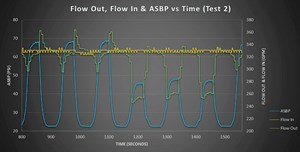
At its core, the system is based on the capability to measure flowrates and fluid properties, in and out of the well, with precise Coriolis flow metering on the main flowline (conventional drilling) or the drilling choke manifold (MPD systems). Additionally, flow-out calculations compensate for rig heave by utilizing sensors to monitor any slip-joint displacement and account for various volume changes.
In addition, the system concept involves collection and analysis of standpipe pressure, hookload measurement, block position measurement, total gas, pressure and temperature from the depth of the subsea blowout preventer (SSBOP) and BHA.
Integrating various rig data into the real-time modeling process allows the advanced kick detection system to provide alerts of specific rig activity that may increase the risk of a kick or loss, and can be used to validate the detection of a well control event, as opposed to generating false alarms. A block diagram layout of the advanced kick detection system is shown in Fig. 6. Initial tests have been performed on this system, and it is under further development.
REDUCING DEEPWATER RISKS WITH THE PDS
The successful testing of the pressure determination system is a significant step in detecting and preventing the development of well control events, as well as proactively utilizing MPD systems to reduce the risk of incurring other non-productive events. It also provides the basis for development of early kick detection. The combined capabilities set the stage for real-time modeling of complex wellbore pressure environments to reduce risks and prevent wellbore events in deepwater wells. ![]()
- Applying ultra-deep LWD resistivity technology successfully in a SAGD operation (May 2019)
- Adoption of wireless intelligent completions advances (May 2019)
- Majors double down as takeaway crunch eases (April 2019)
- What’s new in well logging and formation evaluation (April 2019)
- Qualification of a 20,000-psi subsea BOP: A collaborative approach (February 2019)
- ConocoPhillips’ Greg Leveille sees rapid trajectory of technical advancement continuing (February 2019)

